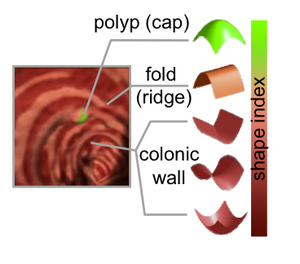NA-MIC NCBC Collaboration:NA-MIC virtual colonoscopy
Back to NA-MIC External Collaborations
Contents
Abstract
Colon cancer, the second leading cause of cancer deaths for men and women in the United States, can be prevented if precursor colonic polyps are detected and removed. The long-term goal of the proposed project is to develop an image visualization and analysis toolkit that advances the early detection of colon cancer. Virtual colonoscopy (VC), also known as computed tomographic colonography (CTC), is a promising technique for colon cancer screening. However, for VC to be a practical screening tool, it should allow for easy visualization of the colonic mucosa, and it should have high accuracy in detecting polyps. Current problems with VC include the difficulties in visualizing the entire mucosal surface in the presence of residual fecal materials, and variations in diagnostic performance among radiologists. Fecal tagging CTC (ftCTC) is a method of tagging stool and fluid remaining in the colon with a radiopaque oral contrast agent, allowing the material to be effectively differentiated from polyps. Non-cathartic ftCTC (ncCTC) is an emerging technique for eliminating rigorous cathartic cleansing from the bowel preparation used in current CTC. Electronic cleansing (EC) is also an emerging technique for removal of tagged fecal materials in VC images, effectively cleansing the colon after image acquisition and visualizing colonic mucosa. Computer-aided detection (CAD), which automatically detects polyps in VC images, has the potential to detect polyps with high sensitivity and specificity, and to improve radiologists' polyp detection performance. The short-term goal of this project is to develop and validate novel visualization and CAD schemes for ncCTC, and to integrate them into the National Alliance of Medical Imaging Computing (NA-MIC) toolkit, thereby developing a NA-MIC VC system. This prototype VC system will expand the NA-MIC toolkit beyond magnetic resonance imaging and neuroimaging, and will establish an easily-extensible VC-research platform that would encourage new research efforts and provide impetus for research collaboration. We hypothesize that the new NA-MIC VC system will allow the visualization of the mucosal surface of the colon, and will improve radiologists' performance in the detection of polyps in ncCTC. To explore these hypotheses, we propose the following specific aims:
- Specific Aim 1: To develop visualization methods of the entire colonic mucosa in ncCTC.
- Specific Aim 2: To develop a CAD scheme for detection of polyps in ncCTC without the use of EC.
- Specific Aim 3: Validate the performance and benefit of the VC system.
Successful development of the NA-MIC VC system will substantially extend the NA-MIC toolkit for providing a sophisticated platform consisting of tools for VC research as well as a VC system that can effectively be used for clinical trials. Such a VC platform will encourage new research efforts and provide impetus for research collaboration. The system also has the potential to provide a CT-based polyp detection scheme that is highly acceptable to patients and highly accurate. Such a VC system will significantly advance the clinical implementation of CT-based colon cancer screening, promote the early diagnosis of colon cancer, and ultimately reduce the mortality due to colon cancer.
PUBLIC HEALTH RELEVANCE
The significance of this project is that successful development of the NA-MIC VC system will substantially extend the NA-MIC toolkit to include a sophisticated platform comprising a set of tools for VC research as well as a VC system that can be used effectively in clinical trials. Such a VC platform would encourage new research efforts and provide impetus for research collaboration. The system also has the potential to provide a CT-based polyp detection scheme that is highly acceptable to patients and highly accurate. We expect that the NA-MIC VC system will improve radiologists' performance in the detection of colonic polyps in CTC, and will be a reliable and acceptable option for screening large patient populations, resulting in early detection of colon cancers and reduced mortality due to colon cancer.
Grant#
R01CA131718
Key Personnel
- MGH: Hiro Yoshida, PI
- NA-MIC: Nobuhiko Hata, Steve Pieper (Isomics)
- Isomics: Alex Yarmarkovich
Funding Duration
01/26/2009-11/30/2012
